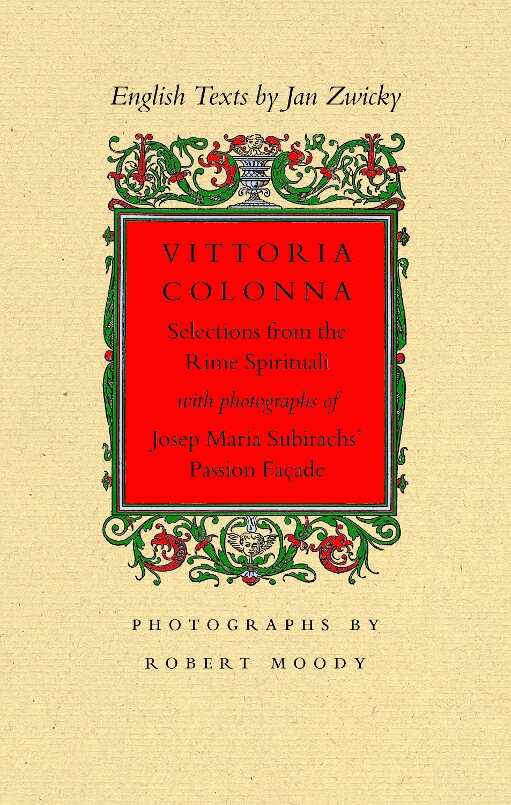Vittoria Colonna
Selections from the Rime Spirituali with Photographs of Josep Maria Subirachs' Passion Façade
The raw honesty and power of sixteenth century poet shines through in Zwicky’s translations.
Jan Zwicky presents her translations of ten sonnets from Vittoria Colonna’s Rime Spirituali, accompanied by stunning photographs by Robert Moody, in Vittoria Colonna: Selections from the Rime Spirituali.
Colonna is not a well-known figure. She was a wealthy sixteenth-century woman who sought the refuge of the convent after she was prematurely widowed. She wrote other forms of poetry, but her later years were marked by meditative religious poems, which came to be known as her rime spirituali. Colonna was an intriguing woman who associated with religious reformers and was a close friend of Michelangelo’s.
Zwicky, who says she came upon Colonna’s work accidentally, has selected ten of the more than one hundred sonnets that make up Colonna’s published Rime Spirituali. While this might not seem a very high ratio, and the book may not satisfy completists for that reason, Zwicky has chosen well. From the first words of the first sonnet, the raw honesty and power of Colonna’s lines is striking:
“All the while my widowed love / flushed me with thoughts of literary fame, / it fed a serpent in my breast / and now, afflicted, languishing, / my only remedy is God.”
As this quotation makes clear, these are free verse sonnets, and for this reason, Zwicky calls them versions rather than translations. Even for those who, like Zwicky, don’t share Colonna’s Christian background, this and other poems serve as moving ruminations by a person in search of something more than what she sees around her. For those inclined to investigate the source text, each sonnet is featured in the original Italian opposite its translation.
The other piece of this partnership of words and images is Moody’s collection of photographs. The ten images don’t directly correspond to the subjects of these poems, but rather serve an overall purpose of placing the reader deeper into the spiritual world Colonna was surrounded by. The photos show scenes from Josep Maria Subirachs’s Passion Façade, part of the exterior of the basilica of the Sagrada Familia in Barcelona. Moody, a mathematician as well as a photographer, captures the controversial, heavily angled sculptures’ dramatic lines in black and white photographs that perfectly utilize shadow and light.
Zwicky and Moody’s collaboration doesn’t have much weight in the traditional sense—lacking in heft, the book can be read in less than an hour. But in another sense, the book’s weight is tremendous; in these short translations, one gains a unique and deeply personal insight into the mind of a woman both haunted and liberated by her beliefs.
Reviewed by
Peter Dabbene
Disclosure: This article is not an endorsement, but a review. The publisher of this book provided free copies of the book and paid a small fee to have their book reviewed by a professional reviewer. Foreword Reviews and Clarion Reviews make no guarantee that the publisher will receive a positive review. Foreword Magazine, Inc. is disclosing this in accordance with the Federal Trade Commission’s 16 CFR, Part 255.

